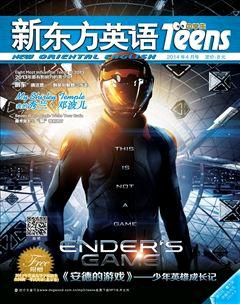2013年六大科学突破
文/By+Robert+Coontz+译/两袖清风


Cancer Immunotherapy1)
This therapy harnesses2) the immune system to battle tumors. Scientists have thought for decades that such an approach to cancer therapy should be possible, but it has been incredibly difficult to make it work. Now many oncologists3) say we have turned a corner4), because two different techniques are helping some patients. One involves antibodies that release a brake5) on T cells6), giving them the power to tackle tumors. Another involves genetically modifying an individual's T cells outside the body so that they are better able to target cancer, and then re-infusing7) them so they can do just that. We are still at the beginning of this story and only a very small proportion of cancer patients have received these therapies. But the results have been repeated at different centers and in different tumor types, giving doctors hope that immunotherapy for cancer may benefit more and more people in the future.
Cloning Human Stem Cells
After more than a decade of failures, researchers announced they had derived stem cells from cloned human embryos8). Such cells can develop into any of the body's cell types, and researchers hope to use them to study and treat diseases. Mice, pigs, dogs, and other animals have been cloned by the same technique used on Dolly the sheep9), but human cells have proved much trickier to work with. In 2013, a new recipe—including a dash of caffeine, which appears to stabilize key molecules in delicate10) human egg cells—solved the problem. Now researchers must determine how embryonic stem cells from the cloned embryos stack up against11) induced pluripotent stem cells12).
Cosmic Particle Accelerator Identified
Cosmic rays—high-energy protons13) and other particles from outer space—were first detected 100 years ago. Now researchers have finally nailed down14) solid evidence of where they come from. Theorists had long suspected that most are accelerated in the shock waves15) from massive exploding stars, or supernovae. If so, they reasoned, some of the particles must collide with atoms in space to produce subatomic particles called pions16), which would then decay17) into gamma rays. In 2013, the Fermi Gamma-Ray Space Telescope spotted the telltale18) pion-decay signature in the debris19) from two supernovae.
Newcomer to the Race to Harness Sunlight
A new breed of materials for solar cells burst into the limelight20) in 2013. Known as perovskites21), they are cheap, easy to make, and already capable of converting 15 percent of the energy in sunlight to electricity. While that remains below the efficiency of commercial silicon solar cells, perovskites are improving fast. One particularly promising feature is that they can be layered on top of silicon solar-cell material to harness a range of wavelengths that neither could capture alone.endprint
Genetic Microsurgery
A year-old gene-editing technique called CRISPR touched off an explosion of research in 2013. It's short for "clustered regularly interspaced short palindromic22) repeats": repetitive stretches of DNA that bacteria have evolved to combat predatory23) viruses by slicing up the viral24) genomes25). The "knife" is a protein called Cas9; in 2012, researchers showed they could use it as a scalpel26) to perform microsurgery on genes. In 2013, the new technology became red-hot, as more than a dozen teams wielded27) it to manipulate specific genes in mice, rats, bacteria, yeast, zebrafish, nematodes28), fruit flies, plants, and human cells, paving the way for understanding how these genes function and possibly harnessing them to improve health.
To Sleep, Perhaps to Clean
Scientists have long speculated that one of the functions of sleep is to restore and repair the brain, but whether this is a "core" purpose of sleep remains controversial. In 2013, researchers found direct experimental evidence that the mouse brain cleans itself during sleep, by expanding channels between neurons that allow an influx29) of cerebrospinal fluid30). The fluid flushes out detritus31) such as amyloid32) proteins, which accumulate as plaques33) in Alzheimer's disease, twice as fast when mice are sleeping as when they are awake.
癌症免疫疗法
这一疗法利用人体免疫系统对抗肿瘤。数十年来,科学家们一直认为这种癌症疗法应该是可行的,只是该疗法一直极难付诸实践。现在,很多肿瘤学家纷纷表示,这一研究已经取得里程碑式的进展,因为如今已有两种不同的免疫疗法可以帮助一些癌症患者。一种方法是通过抗体减少T细胞的抑制因素,从而充分发挥T细胞的抗癌能力。另一种方法是通过对患者的T细胞进行体外基因改造,提高T细胞的抗癌能力,然后再将这些T细胞注入患者体内,从而发挥抗癌作用。癌症免疫疗法目前仍然处于起步阶段,至今只有极少数癌症患者接受过这类治疗。不过,癌症免疫疗法的效果已在不同的治疗中心和不同类型的肿瘤上得到反复证实,这给了医生们一线希望——癌症免疫疗法将来或许能够造福更多的患者。
人类干细胞的克隆
经历十余年的失败之后,研究人员宣布,他们从克隆的人类胚胎中提取出了干细胞。这些干细胞可以培育成人体内任一类型的细胞,研究人员希望能够利用它们来研究和治疗疾病。尽管人类早已运用克隆多莉羊的技术克隆出了小鼠、猪、狗以及其他一些动物,但事实证明克隆人体细胞更为棘手。2013年出现的一种新方法解决了这一难题,该方法中用到了少量咖啡因,而咖啡因似乎能稳定脆弱的人类卵细胞中的核心分子。现在,研究人员必须要确定的是,通过克隆胚胎获得的胚胎干细胞和诱导性多能干细胞相比,两者孰优孰劣。
宇宙粒子“加速器”的发现
宇宙射线是指来自外太空的高能质子和其他粒子,于100年前首次被人类发现。现在,研究人员终于找到了宇宙射线来源的有力证据。理论家们早就怀疑,大部分宇宙射线是经由大质量恒星爆炸(即超新星)产生的激波高速抛出的。如果确实如此,他们推断,宇宙射线中的某些粒子肯定会跟太空中的原子发生碰撞,产生一种称为“π介子”的亚原子粒子,继而衰变成伽马射线。2013年,费米伽马射线太空望远镜在两个超新星残骸里发现了证明π介子衰变存在的特征。
太阳能利用领域喜添新成员
2013年,一种新型太阳能电池材料突然成为关注的焦点,这就是钙钛矿太阳能电池。 钙钛矿太阳能电池成本低廉,易于制造,目前已能够将15%的太阳能转换成电能。尽管该效能仍然低于商用硅太阳能电池,但钙钛矿太阳能电池发展迅猛,且具有一个十分有发展前景的特点,即可以将其铺在硅太阳能电池材料上面,以此将两者单独使用时无法吸取的一段波长的太阳能转化为电能。
基因“显微外科手术”
2013年,问世仅一年的基因编辑技术CRISPR掀起了一股科研狂潮。CRISPR为“规律成簇间隔短回文重复序列”的缩略语,是指细菌进化而来的一段DNA重复序列,可通过切割病毒基因组的方式抵御攻击性病毒。切割病毒基因组的这把“刀”是一种名叫Cas9的蛋白质。2012年,研究人员发现,他们可将Cas9蛋白质用作“手术刀”对基因进行显微外科手术。2013年,这项新技术成为一个研究热点,超过12个研究团队利用该技术来操纵小鼠、老鼠、细菌、酵母、斑马鱼、线虫、果蝇、植物和人类细胞的特定基因,为进一步了解这些基因的运作机制甚至利用这些基因来改善机体健康做好准备。endprint
大脑可能在利用睡眠进行“大扫除”
长期以来,科学家们一直猜测睡眠的作用之一是恢复和修复大脑机能,但对这是否为睡眠的“主要”目的这一问题尚存争议。2013年,研究人员找到了直接的实验证据,表明小鼠的大脑在睡眠期间能够通过扩展神经元之间的通道,使大量脑脊髓液注入其中,以此进行自我清理。小鼠在睡眠时,其脑脊髓液会以两倍于清醒时的速度清理掉神经元间通道内的残余物,比如淀粉样蛋白——这种蛋白一旦积聚,就会形成导致老年痴呆症的噬斑。
1. immunotherapy [??mj?n???θ?r?p?] n.【医】免疫疗法
2. harness [?hɑ?n?s] vt. 利用(或控制)……以产生动力,利用
3. oncologist [???k?l?d??st] n. 肿瘤学家
4. turn a corner: 进入一个新的局面(阶段、时期)
5. brake [bre?k] n. 起抑制作用的因素,约束
6. T cell: T细胞,一种多能干细胞,具有细胞免疫和免疫调节功能。
7. infuse [?n?fju?z] vt. 把……注入
8. embryo [?embri??] n. 胚胎
9. Dolly the sheep: 克隆羊多莉,是1996年英国科学家克隆成功的一头母羊,标志着科学界克隆成就的一大飞跃。
10. delicate [?del?k?t] adj. 纤弱的
11. stack up against: 与……较量,争胜负
12. induced pluripotent stem cell: 诱导性多能干细胞,指通过诱导重新编程技术将细胞转变为类似胚胎干细胞的多能干细胞。
13. proton [?pr??t?n] n. 质子
14. nail down: 弄清;确定
15. shock wave: 激波,又称冲击波,是气体、液体和固体介质中压强、密度和温度在波阵面上发生突跃变化的压缩波。在超声速流动、爆炸等过程中都会出现激波。
16. pion [?pa??n] n. π介子
17. decay [d??ke?] vi.【物】(放射性物质等)衰减,衰变
18. telltale [?telte?l] adj. 能证明(某事)存在的
19. debris [?debri?] n. (被毁物的)残骸;瓦砾
20. limelight [?la?mla?t] n. 公众注意的中心
21. perovskite [p??r?vska?t] n. 钙钛矿
22. palindromic [?p?l?n'dr?m?k] adj. 回文结构的
23. predatory [?pred?tri] adj. (动物或其习性)以捕食其他动物为生的;掠夺(性)的
24. viral [?va?r?l] adj. 【医】病毒(性)的;病毒引起的
25. genome [?d?i?n??m]
n.【生】基因组,染色体组
26. scalpel [?sk?lp?l] n. 解剖刀,一种外科手术刀
27. wield [wi?ld] vt. 挥;操;使用
28. nematode [?nem?t??d] n.【动】线虫
29. influx [??nfl?ks] n. 流入,注入;涌进
30. cerebrospinal fluid: 脑脊(髓)液
31. detritus [d??tra?t?s] n. 残余物
32. amyloid [??m??l??d] adj. 淀粉状的
33. plaque [pl?k] n.【医】血小板;斑。这里指大脑组织中的噬斑。endprint

